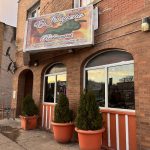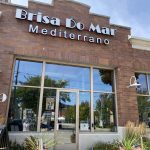public art or urban eyesore?
By Raymond Johnson
One of the happiest developments in recent years is the explosion of sidewalk seating at restaurants and cafés in Milwaukee. It signals a renewed commitment to public life, or at least as close as we are able to achieve it in an age in which we are always and everywhere shopping. It seems nearly every establishment that is able has put a few tables out, even the Famous Cigar Shop on Brady St., so that smokers can enjoy their purchases immediately. Brady, perhaps the city’s most public street, has been literally transformed in recent years by the number of establishments with sidewalk seating.
All this sidewalk seating, however, is not without drawbacks. The placement of private seating on sidewalks in part co-opts the public realm. Restaurants and cafés with seating on the sidewalk are making money in this public space. Such taking demands something be given back, a responsibility too few uphold.
First and foremost amongst these is a requirement to keep the sidewalk passable. Legally, sidewalk seating may not encroach upon a wheelchair user, whose right to sidewalk use is unquestioned. Additionally, seating should allow for the passage of two people shoulder to shoulder holding hands. This distance, four to five feet, is about the width of a residential sidewalk. Couples shouldn’t have to break handholding to bypass outdoor grazers. That on too many of Milwaukee’s commercial streets (Kinnickinnic Av., Center St., Water St.) this would be nearly impossible, signals dysfunctional urban design.
Recent violators have included Rock Bottom Brewery on the Riverwalk and Hooligan’s on North Ave. Rock Bottom has been the most serious offendor. In the past, it has placed tables along the narrow right of way east of the restaurant’s parking lot, although this practice seems to have stopped. Rock Bottom still packs its tables onto their main Riverwalk space, blurring the public passage and making those strolling by feeling as if they are walking through a dining room rather than on a sidewalk. Hooligan’s infringements have been less premeditated. Some days there is plenty of space, others not enough even for wheelchair users. Of course it is not only the establishments that are responsible for maintaining the public way. All of us who enjoy outdoor seating must remain cognizant of the amount of space we leave to passersby. This is simply a requirement of living in and using a dense urban environment.
The other primary responsibility placed upon establishments utilizing sidewalk seating is aesthetic. Many establishments treat this public responsibility callously. They have simply gone to the local hardware store and purchased the ubiquitous plastic chairs and tables found on every backyard deck from New Berlin to Menomonee Falls. They are fine for that use, but inappropriate for urban sidewalks. There are too many of these places to mention them all.
Sidewalk seating as public art.
Others are trying harder. Hartter’s Bakery on Prospect Ave., and Cempazuchi’s and on Brady St. feature colored translucent resin slat chairs that add vibrancy to their locales. The sidewalk furniture at Cush on North Ave. is an industrial metal mesh. The Hi Hat on Arlington St. employs a similar aesthetic.
Brewed Awakenings on Brady has some colorful steel café tables, while the Nomad on Brady attaches small square tables directly to the side of its building. Unfortunately, both then surround their tables with the same ubiquitous plastic chairs.
Gil’s Café commissioned metal artist Todd Burton to fabricate brushed steel tables and rusted metal torches for its space on the corner of Downer and Hackett. Todd Burton produced more tables for BBC on North, as well as a polished metal fence to surround their seating, better defining the public way. Alterra on Prospect commissioned artist Joe Niedzialkowski to design its awnings as well as the flowerboxes that surround its’ seating. Soup Bros. demonstrates that the issue is not money but creativity. They have set unmatched seating, numerous benches, and a couple of ‘plant ladders’ to their space on Florida St., creating an urban oasis in an often barren area of the city.
Overall, these places offer instruction to proprietors adding sidewalk seating. Don’t just stop by the hardware store on some Monday in May. Many catalogs exist that sell inexpensive but smart-looking outdoor seating. Think beyond just tables and chairs. Consider flowerboxes, torches, small gardens or fountains, and even public art. Finally, if possible, make the seating itself public art. Hire local architects to develop creative schemes for the outdoor space. Commission local artists/industrial designers to fabricate original pieces. After all, this is the city, not some suburban backyard deck. It is the least one can do in return for borrowing a piece of the public realm.


















